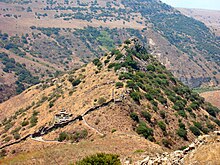גמלא | |
 The acropolis of Gamla | |
| Alternative name | Al-Sunâm ("Camel's Hump") |
|---|---|
| Location | Golan Heights, Syria |
| Coordinates | 32°54′10″N 35°44′26″E / 32.90278°N 35.74056°E |
| Type | Fortification and settlement |
| History | |
| Material | Basalt |
| Founded | 3rd century BCE |
| Abandoned | 67 CE |
| Periods | Hellenistic to Roman Empire |
| Site notes | |
| Excavation dates | 1978–2000 |
| Archaeologists | Shmarya Guttman, Danny Sion |
| Management | INPA[1] |
| Website | Gamla Nature Reserve |
Gamla (Hebrew: גַּמְלָא, lit. the camel), also Gamala, was an ancient Jewish town on the Golan Heights. Believed to have been founded as a Seleucid fort during the Syrian Wars, it transitioned into a predominantly Jewish settlement that came under Hasmonean rule in 81 BCE.[2][3] The town's name reflects its location on a high, elongated ridge with steep slopes resembling a camel's hump.[4]
Gamla served as a key rebel stronghold during the Great Jewish Revolt against Rome. In the summer of 67 CE, after an extended siege and battle, Roman forces under Vespasian ultimately captured the town and massacred its inhabitants.[5] The Jewish historian Josephus, who accompanied the Roman army, provides detailed accounts of these events in his work, "The Jewish War."[6]
The remains of Gamla were discovered in the 1968 survey of the Golan,[4] with geographical features matching Josephus' descriptions.[7] Located approximately 10 kilometers inland from the Sea of Galilee,[4] the town was built on the southeastern slope of Mount Gamla.[7] Archaeological excavations, starting in 1970 and continuing periodically, have unearthed city walls enclosing an area of about 180 dunams, a water conduit system, ritual baths, Herodian lamps, stone vessels, and thousands of Hasmonean coins.[8][9] One of the earliest synagogues in the Land of Israel, believed to date back to the late 1st century BCE, was discovered near the town wall in 1976.[4][10][11]
Due to its historical significance during the revolt, Gamla is a symbol for the modern state of Israel and an important archaeological site.[8] It is located within the Gamla Nature Reserve and serves as a prominent tourist attraction. The site features ruins available for visitation and is home to various wildlife, including rock hyraxes, wild boars, and numerous species of raptors.[5]


- ^ "Israel Nature and Parks Authority". Archived from the original on 2012-03-14. Retrieved 2010-12-01.
- ^ Cite error: The named reference
AndreaBerlinwas invoked but never defined (see the help page). - ^ Cite error: The named reference
:3was invoked but never defined (see the help page). - ^ a b c d Joyce, Marilyn; Segal; Chiat (1982). Handbook of Synagogue Architecture. Brown Judaic Studies. Vol. 28. Brown University. pp. 282–283. ISBN 0-89130-524-6.
- ^ a b Rogers, Guy MacLean (2021). For the Freedom of Zion: the Great Revolt of Jews against Romans, 66-74 CE. New Haven: Yale University Press. pp. 252, 258–259, 537. ISBN 978-0-300-24813-5.
- ^ Gamla III (1). p. 12
- ^ a b Aviam, Mordechai (2007-01-01), "The archaeological illumination of Josephus' narrative of the battles at Yodefat and Gamla", Making History, Brill, p. 373, doi:10.1163/ej.9789004150089.i-471.126, ISBN 978-90-474-0906-9, retrieved 2024-06-06
- ^ a b Cite error: The named reference
evidencewas invoked but never defined (see the help page). - ^ Cite error: The named reference
YAwas invoked but never defined (see the help page). - ^ Cite error: The named reference
:0was invoked but never defined (see the help page). - ^ Cite error: The named reference
YUPwas invoked but never defined (see the help page).
